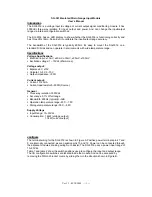
6
Building Technologies
A6V10214492_a_en_--
Fire safety and security products
03.2010
Installation
Fig. 9
Fig. 10
Fig. 11
Fig. 12 Detection line connection
Preparation
1.
Determine type of installation:
–
Installation outside a switching cabinet or a control unit:
use FDCH221 housing (Fig. 10) .
–
Installation directly in a switching cabinet or a control unit:
mount the module on an even surface (Fig. 9).
Damage by water!
In humid or wet environments always use FDCH221 housing!
Mounting FDCH221 housing
1.
Open the housing.
2.
Determine the position of the cable entries in the housing
and break them out.
3.
Mount the housing on an even surface with two screws
(Fig. 10). Distance between holes: 182.0
±
1.0mm.
4.
Insert the cables and fix the cables in the housing.
5.
Insert the seal and fix the lid additionally with four screws
(Fig. 11) (only this way is IP65 protection guaranteed).
The housing lid is transparent. Consider a suitable
installation position to make sure that the LEDs of the
module are visible at any time.
Procedure with installation in the housing
CAUTION
Overheating of the in/output module!
1.
Open the housing.
2.
Place the module in the housing and fix it with two
screws (Fig. 9/10).
3.
Close the housing.
Procedure with installation on an even surface
1.
Place the module on an even surface.
2.
Fix the module with two screws (M4 X15) (Fig. 9).
Distance between holes: 63.5
±
1.0mm
Electric connection
1.
Referring to Fig. 1,3,5,7,12 connect the cables to the
corresponding terminals.
2.
Connect resistor/ diode .The resistors must be
connected at the end of the monitored line.
3.
Fix the cables to the module
CAUTION
Mind the positive and negative polar when connecting the
diodes.

























